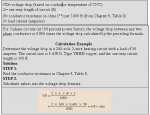Re: voltage drop K constants, units of...
K = 12.9 copper
K = 21.2 aluminum
For you who are enthusiasts for keeping up with the 'units' in your electrical calculations, what are the units of the 'k factor', as
listed above and as used in voltage drop calculations?
My guess is that the units are:
(ohms cmils)/feet
In other words, for copper
K = 12.9 (ohms cmils)/feet
in other words, 'ohms cmils' in numerator, 'feet' in denominator.
What say you ? What do you say are the units ?
--Thanks.
K = 12.9 copper
K = 21.2 aluminum
For you who are enthusiasts for keeping up with the 'units' in your electrical calculations, what are the units of the 'k factor', as
listed above and as used in voltage drop calculations?
My guess is that the units are:
(ohms cmils)/feet
In other words, for copper
K = 12.9 (ohms cmils)/feet
in other words, 'ohms cmils' in numerator, 'feet' in denominator.
What say you ? What do you say are the units ?
--Thanks.
Last edited:


